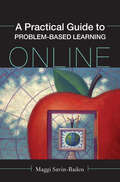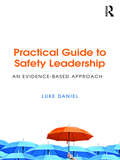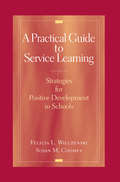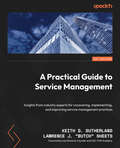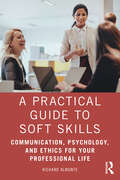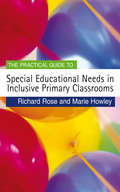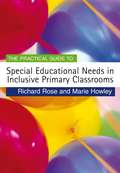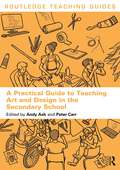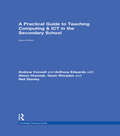- Table View
- List View
A Practical Guide to Problem-Based Learning Online
by Maggi Savin-BadenProblem-based learning online is a burgeoning area, crying out for support in all the disciplines, but particularly health, medicine, education and social care that are already advanced users of problem-based learning in higher education. This book provides highly grounded research based ways for those wanting to change problem-based learning modules and programs from face to face to online approaches, as well as those who have developed e-learning components but who want to adopt problem-based methods. Providing an overview of the current state of problem based learning online, it examines why we're moving from fact to face to online provision, considers existing forms of provision, outlines common mistakes and strategies to avoid future problems, and shows how to effectively facilitate learning. Illustrated by mini case studies and examples of international projects, it provides guidance on effective design, online collaboration and group dynamics, and explores the common, and complex, decisions faced when choosing which form of problem-based learning to adopt. Including practical information and resources for games and activities, scenarios of problem-based learning in the different disciplines, advice for supporting staff and students, and effectively evaluating the tools, skills and pedagogy needed for learning, this book is an essential guide for all practitioners involved in the design and delivery of problem based learning online.
A Practical Guide to Pupil Wellbeing: Strategies for classroom teachers
by Kirsten ColquhounEvery year thousands of research papers, guidance documents and educational aims are published on pupil mental health and wellbeing. Many of them offer insightful ideas and theories, but what is often lacking is a clear route for busy classroom teachers to apply these findings. A focus on wellbeing is here to stay, but what does it mean? How does it apply to the curriculum? And what is a teacher's role? This book critically explores the importance of being a research-informed teacher, assesses some of the key health and wellbeing areas that class teachers can directly affect, and offers practical advice on how to do this. Designed in part to create a clearer pathway for classroom teachers to ensure that, while already spinning their many existing plates, the health and wellbeing needs of their pupils can be met effectively.Teaching, like healthcare, has infinite capabilities to contribute to social improvement both for the individual and wider society. Teachers go above and beyond their job description every single day and face a myriad of challenges in doing so. This book will help to arm class teachers with a toolkit of information to help them succeed as teachers of health and wellbeing.
Practical Guide to Safety Leadership: An Evidence-Based Approach
by Luke DanielLeaders can shape an organisation through their behaviours and their vision. If an organisation lacks a clear vision or there is disengagement by the leadership team, then the results can be disastrous. In such circumstances change is needed. When change is needed, the value of safety can become a change agent. From the disciplines of leadership and safety comes the emerging topic of safety leadership. Through safety leadership, workplace challenges can be rectified and the desired behaviours reinforced. These challenges can span from a lack of leadership engagement, poor safety performance, complacency or lack of safety ownership. Understanding how safety leadership differs from other leadership theories can give you a competitive edge which is not solely based upon financial quotas, but instead based upon the moral code of ensuring the health and well-being of your employees. This book goes beyond mere safety slogans or anecdotal stories that relate to safety leadership. Instead an empirical and research-based approach will be shared which can help improve the overall culture of an organisation as well as the safety of employees. Tools, case studies, theories and practical applications will be shared which can help create the blueprint for organisational change that you seek. Even when things are working well, constant innovation and adoption of best practices can help companies go from good to great and leave a lasting legacy for employees and customers alike. Detailing the mechanics of safety leadership, this book will drive the change and results you want.
Practical Guide to Safety Leadership: An Evidence-Based Approach
by Luke DanielLeaders can shape an organisation through their behaviours and their vision. If an organisation lacks a clear vision or there is disengagement by the leadership team, then the results can be disastrous. In such circumstances change is needed. When change is needed, the value of safety can become a change agent. From the disciplines of leadership and safety comes the emerging topic of safety leadership. Through safety leadership, workplace challenges can be rectified and the desired behaviours reinforced. These challenges can span from a lack of leadership engagement, poor safety performance, complacency or lack of safety ownership. Understanding how safety leadership differs from other leadership theories can give you a competitive edge which is not solely based upon financial quotas, but instead based upon the moral code of ensuring the health and well-being of your employees. This book goes beyond mere safety slogans or anecdotal stories that relate to safety leadership. Instead an empirical and research-based approach will be shared which can help improve the overall culture of an organisation as well as the safety of employees. Tools, case studies, theories and practical applications will be shared which can help create the blueprint for organisational change that you seek. Even when things are working well, constant innovation and adoption of best practices can help companies go from good to great and leave a lasting legacy for employees and customers alike. Detailing the mechanics of safety leadership, this book will drive the change and results you want.
A Practical Guide to Service Learning: Strategies for Positive Development in Schools
by Felicia L. Wilczenski Susan M. CoomeyThis book describes how service learning, an intervention that can be both remedial or preventive and individual or systemic, can enable school psychologists to expand their role beyond special populations to serve students within the academic mainstream. It draws connections between the positive psychology movement, the nurturing of purpose in youth, and the benefits of service learning.
A Practical Guide to Service Management: Insights from industry experts for uncovering, implementing, and improving service management practices
by Keith Sutherland Lawrence SheetsDevelop and improve the service management capabilities of your organization or business with this comprehensive handbookKey FeaturesA complete, pragmatic guide on service management from industry expertsLearn industry best practices and proven strategies to establish and improve a service management capabilityGet hands on with implementing and maintaining a service management capabilityPurchase of the print or Kindle book includes a free PDF eBookBook DescriptionMany organizations struggle to find practical guidance that can help them to not only understand but also apply service management best practices. Packed with expert guidance and comprehensive coverage of the essential frameworks, methods, and techniques, this book will enable you to elevate your organization’s service management capability. You’ll start by exploring the fundamentals of service management and the role of a service provider. As you progress, you’ll get to grips with the different service management frameworks used by IT and enterprises. You'll use system thinking and design thinking approaches to learn to design, implement, and optimize services catering to diverse customer needs. This book will familiarize you with the essential process capabilities required for an efficient service management practice, followed by the elements key to its practical implementation, customized to the organization’s business needs in a sustainable and repeatable manner. You’ll also discover the critical success factors that will enhance your organization’s ability to successfully implement and sustain a service management practice. By the end of this handy guide, you’ll have a solid grasp of service management concepts, making this a valuable resource for on-the-job reference.What you will learnDiscover a holistic approach to managing servicesGet acquainted with the service management methods, frameworks, and best practicesUnderstand the significance of a service management strategyDemonstrate your skills to deliver high-quality, timely servicesFind out how to become a respected business partner to your customersRecognize the role of governance, outcomes, and marketsGrasp the concept of value capture and maintaining value over timeExplore common processes that lay the foundation for effective service managementWho this book is forThis book is for anyone interested in gaining a general understanding of the value of enterprise/IT service management (ESM/ITSM), including but not limited to IT leadership, key business managers, business process analysts, business analysts, IT consultants, IT professionals, project managers, systems integrators, service desk managers, managed service providers, solution providers, and sales staff. Whether you’re new to service management or have prior experience, you’ll find valuable insights in this book.
A Practical Guide to Shakespeare for the Primary School: 50 Lesson Plans using Drama
by John DoonaShakespeare is one of our key historical figures but so often he remains locked behind glass and hard to reach. The purpose of this book is to unlock Shakespeare, to remove the tag of ‘high art’ that has surrounded his work and return him to the heart of popular culture where his plays began in the first place. In his foreword, playwright Edward Bond says of A Practical Guide to Shakespeare for the Primary School, ‘It is written with knowledge and experience of its subject – but also with the knowledge of the young people with whom that experience was shared‘. John Doona will inspire and motivate pupils and teachers alike to engage with Shakespeare in a fresh and accessible manner and provide clear, tried and tested schemes of work which demonstrate how engagement with the plays and their language can have a dramatic impact on children’s literacy and writing. As well as providing practical guidance to classroom delivery and performance, techniques, approaches and attitudes, this handbook also promotes learning outcomes linked to literacy targets and cross-curricular units of learning. The central chapters of the book form a comprehensive cross-curricular unit of work on four specific plays – The Tempest, Macbeth, A Midsummer Night’s Dream and Romeo and Juliet – providing background notes and historical facts linked to the plays, along with comprehensive schemes of work for immediate implementation and ideas for generating performance. Features unique to this resource include:- Free electronic ‘info-blasts’ to all book buyers containing electronic versions of key elements of the book as well as additional resources and lesson plans Drama for the Petrified - A crash course for teachers in the techniques, approaches and attitudes required to bring Shakespeare to life A chapter on Shakespeare and his life, including ‘Five minute Will’ a short comic scripted account of his life Comprehensive schemes of work, each including a Teachers’ Crib Sheet, Story Whoosh!, Story Jigsaw, Scheme Structure Map, edited scenes and additional classroom resources A Practical Guide to Shakespeare for the Primary School is an essential resource for all primary teachers, trainee teachers and drama practitioners, offering guidance, insight and compelling schemes of work for the study of Shakespeare through drama in the primary classroom.
A Practical Guide to Shakespeare for the Primary School: 50 Lesson Plans using Drama
by John DoonaShakespeare is one of our key historical figures but so often he remains locked behind glass and hard to reach. The purpose of this book is to unlock Shakespeare, to remove the tag of ‘high art’ that has surrounded his work and return him to the heart of popular culture where his plays began in the first place. In his foreword, playwright Edward Bond says of A Practical Guide to Shakespeare for the Primary School, ‘It is written with knowledge and experience of its subject – but also with the knowledge of the young people with whom that experience was shared‘. John Doona will inspire and motivate pupils and teachers alike to engage with Shakespeare in a fresh and accessible manner and provide clear, tried and tested schemes of work which demonstrate how engagement with the plays and their language can have a dramatic impact on children’s literacy and writing. As well as providing practical guidance to classroom delivery and performance, techniques, approaches and attitudes, this handbook also promotes learning outcomes linked to literacy targets and cross-curricular units of learning. The central chapters of the book form a comprehensive cross-curricular unit of work on four specific plays – The Tempest, Macbeth, A Midsummer Night’s Dream and Romeo and Juliet – providing background notes and historical facts linked to the plays, along with comprehensive schemes of work for immediate implementation and ideas for generating performance. Features unique to this resource include:- Free electronic ‘info-blasts’ to all book buyers containing electronic versions of key elements of the book as well as additional resources and lesson plans Drama for the Petrified - A crash course for teachers in the techniques, approaches and attitudes required to bring Shakespeare to life A chapter on Shakespeare and his life, including ‘Five minute Will’ a short comic scripted account of his life Comprehensive schemes of work, each including a Teachers’ Crib Sheet, Story Whoosh!, Story Jigsaw, Scheme Structure Map, edited scenes and additional classroom resources A Practical Guide to Shakespeare for the Primary School is an essential resource for all primary teachers, trainee teachers and drama practitioners, offering guidance, insight and compelling schemes of work for the study of Shakespeare through drama in the primary classroom.
A Practical Guide to Soft Skills: Communication, Psychology, and Ethics for Your Professional Life
by Richard AlmonteThis accessible text looks at the range of soft skills sought after by employers and provides a practical guide to developing and effectively demonstrating these skills. Soft skills -- including communication, customer service, teamwork, problem solving, and personal management -- represent a major component of any worker's professional identity. This book analyzes major soft skills, including both inward-facing soft skills (how workers manage themselves to effectively perform their work) and outward-facing skills (how workers effectively interact with others and in groups). It explores how these skills are rooted in fundamental areas of liberal arts including interpersonal communication, psychology, and ethics. It provides an active learning pedagogy, including creative exercises and case studies through which students can assess their understanding of underlying concepts and their application in real-world situations. The book can be used as a supplement for communication, business, and career-oriented courses, and it will be of interest to individual students and junior professionals as well as career counselors, postsecondary instructors across the curriculum, and professionals in human resources and learning and development.
A Practical Guide to Soft Skills: Communication, Psychology, and Ethics for Your Professional Life
by Richard AlmonteThis accessible text looks at the range of soft skills sought after by employers and provides a practical guide to developing and effectively demonstrating these skills. Soft skills -- including communication, customer service, teamwork, problem solving, and personal management -- represent a major component of any worker's professional identity. This book analyzes major soft skills, including both inward-facing soft skills (how workers manage themselves to effectively perform their work) and outward-facing skills (how workers effectively interact with others and in groups). It explores how these skills are rooted in fundamental areas of liberal arts including interpersonal communication, psychology, and ethics. It provides an active learning pedagogy, including creative exercises and case studies through which students can assess their understanding of underlying concepts and their application in real-world situations. The book can be used as a supplement for communication, business, and career-oriented courses, and it will be of interest to individual students and junior professionals as well as career counselors, postsecondary instructors across the curriculum, and professionals in human resources and learning and development.
The Practical Guide to Special Educational Needs in Inclusive Primary Classrooms
by Marie Howley Professor Richard Rose`A well-written and thought-provoking book for teachers. It offers many ideas to improve inclusive practice in primary schools, to the benefit of all pupils, not only those with additional or different learning needs' - Special magazine Written for newly-qualified teachers and students approaching the end of their training courses, this practical and accessible text is an introduction to working with children of a range of abilities in inclusive primary classrooms. The book draws on recent research and innovation in the education of pupils with special educational needs to provide practical examples and advice on how to meet the challenges of developing effective teaching and learning in inclusive settings. Chapters cover: " becoming an inclusive teacher " pupils giving cause for concern " teaching and learning styles " creating inclusive classroom environments and teaching teams " learning from pupils " looking beyond school " developing further as a professional With advice on building positive attitudes, developing specific teaching strategies and adapting a personalising teaching approaches, the book helps teachers to build upon their earlier training in both practical and reflective ways. Richard Rose is Professor of Special and Inclusive Education and Director of the Centre for Special Needs Education and Research at University College Northampton. Marie Howley is senior lecturer in the Centre for Special Needs Education and Research at University College Northampton, teaching on both undergraduate and post graduate courses and in continuing professional development for teachers.
The Practical Guide to Special Educational Needs in Inclusive Primary Classrooms (PDF)
by Marie Howley Professor Richard Rose`A well-written and thought-provoking book for teachers. It offers many ideas to improve inclusive practice in primary schools, to the benefit of all pupils, not only those with additional or different learning needs' - Special magazine Written for newly-qualified teachers and students approaching the end of their training courses, this practical and accessible text is an introduction to working with children of a range of abilities in inclusive primary classrooms. The book draws on recent research and innovation in the education of pupils with special educational needs to provide practical examples and advice on how to meet the challenges of developing effective teaching and learning in inclusive settings. Chapters cover: " becoming an inclusive teacher " pupils giving cause for concern " teaching and learning styles " creating inclusive classroom environments and teaching teams " learning from pupils " looking beyond school " developing further as a professional With advice on building positive attitudes, developing specific teaching strategies and adapting a personalising teaching approaches, the book helps teachers to build upon their earlier training in both practical and reflective ways. Richard Rose is Professor of Special and Inclusive Education and Director of the Centre for Special Needs Education and Research at University College Northampton. Marie Howley is senior lecturer in the Centre for Special Needs Education and Research at University College Northampton, teaching on both undergraduate and post graduate courses and in continuing professional development for teachers.
A Practical Guide to Staff Development and Appraisal in Schools (Books For Teachers Ser.)
by Horne, Helen Pierce, AnthonyThis guide contains an overview of existing successful appraisal practices and practical suggestions for both those managing and undertaking appraisal. The book takes into account up-to-date policies and changes in appraisal.
A Practical Guide to Staff Development and Appraisal in Schools
by Horne, Helen Pierce, AnthonyThis guide contains an overview of existing successful appraisal practices and practical suggestions for both those managing and undertaking appraisal. The book takes into account up-to-date policies and changes in appraisal.
A Practical Guide To Studying History: Skills And Approaches (PDF)
by Tracey LoughranA Practical Guide to Studying History is the perfect guide for students embarking on degree-level study. The book: - introduces students to the concepts of historical objectivity, frameworks and debate - explains the differences in aims, methods and audiences for different types of history - explores the relationship between the skills developed during a history undergraduate degree and the practice of professional history - helps students develop the practical skills required to read historical writing critically, write good essays, and participate in historical debates - includes study questions, further reading lists, text boxes, maps and illustrations The book incorporates case studies taken from a range of regions and periods, reflecting the varied nature of historical study at university, and helps students to understand history, and to practice it successfully: it is an indispensable guide to studying history.
A Practical Guide to Studying History: Skills and Approaches
by Tracey Loughran*** PROSE Award Winner (2018) in the Textbook/Humanities Category ***A Practical Guide to Studying History is the perfect guide for students embarking on degree-level study. The book: - introduces students to the concepts of historical objectivity, frameworks and debate- explains the differences in aims, methods and audiences for different types of history- explores the relationship between the skills developed during a history undergraduate degree and the practice of professional history- helps students develop the practical skills required to read historical writing critically, write good essays, and participate in historical debates- includes study questions, further reading lists, text boxes, maps and illustrationsThe book incorporates case studies taken from a range of regions and periods, reflecting the varied nature of historical study at university, and helps students to understand history, and to practice it successfully: it is an indispensable guide to studying history.
A Practical Guide to Studying History: Skills and Approaches
by Tracey Loughran*** PROSE Award Winner (2018) in the Textbook/Humanities Category ***A Practical Guide to Studying History is the perfect guide for students embarking on degree-level study. The book: - introduces students to the concepts of historical objectivity, frameworks and debate- explains the differences in aims, methods and audiences for different types of history- explores the relationship between the skills developed during a history undergraduate degree and the practice of professional history- helps students develop the practical skills required to read historical writing critically, write good essays, and participate in historical debates- includes study questions, further reading lists, text boxes, maps and illustrationsThe book incorporates case studies taken from a range of regions and periods, reflecting the varied nature of historical study at university, and helps students to understand history, and to practice it successfully: it is an indispensable guide to studying history.
A Practical Guide to Teacher Education Evaluation (Evaluation in Education and Human Services #27)
by Mary F. Berney Jerry B. AyersJ. T. Sandefur Western Kentucky University American's ability to compete in world markets is eroding. The productivity growth of our competitors outdistances our own. The capacity of our economy to provide a high standard of living for all our people is increasingly in doubt. As jobs requiring little skill are automated or go offshore and demand increases for the highly skilled, the pool of educated and skilled people grows smaller and the backwater of the unemployable rises. Large numbers of American children are in limbo--ignorant of the past and unprepared for the future. Many are dropping out--notjust out of school--but out of productive society. These are not my words. They are a direct quote from the Executive Summary of the Carnegie Forum Report on Education and the Economy entitled A Nation Prepared: Teachers for the 21st Century (p. 2, 1986). This report was motivated by four purposes: 1. To remind Americans, yet again, of the economic challenges pressing us on all sides; 2. To assert the primacy of education as the foundation of economic growth, equal opportunity and a shared national vision; 3. To reaffirm that the teaching profession is the best hope for establishing new standards of excellence as the hallmark of American education; and 4. To point out that a remarkable window of opportunity lies before us in the next decade to reform education, an opportunity that may not present itself again until well into the next century.
A Practical Guide to Teacher Wellbeing: A practical guide
by Elizabeth HolmesTeacher wellbeing, or a lack of it, is a major concern for the teaching profession. Research shows that there is a recruitment and retention crisis with over a third of the school, FE and HE profession expecting to leave by 2020. This is a practical guide that will help trainee teachers prepare for what is, undoubtedly, a demanding job. It supports new teachers to be aware of themselves and to understand the schools and teaching sector so they better anticipate pressures and find their own way forward. With solutions and strategies that can be taken into practice, this guide will help new and early career teachers establish that all-important work/life balance and avoid burn out.
A Practical Guide to Teacher Wellbeing: A practical guide
by Elizabeth HolmesTeacher wellbeing, or a lack of it, is a major concern for the teaching profession. Research shows that there is a recruitment and retention crisis with over a third of the school, FE and HE profession expecting to leave by 2020. This is a practical guide that will help trainee teachers prepare for what is, undoubtedly, a demanding job. It supports new teachers to be aware of themselves and to understand the schools and teaching sector so they better anticipate pressures and find their own way forward. With solutions and strategies that can be taken into practice, this guide will help new and early career teachers establish that all-important work/life balance and avoid burn out.
A Practical Guide to Teaching Art and Design in the Secondary School (Routledge Teaching Guides)
by Andy Ash Peter CarrA Practical Guide to Teaching Art and Design in the Secondary School bridges the gap between key themes in Art and Design education theory, professional practice and the classroom. This practical and accessible book introduces methods for the delivery of engaging Art and Design lessons that safely and meaningfully address the current key issues in the subject.Each chapter includes tasks to support trainee and early career teachers in implementing, reviewing and adapting their teaching. Chapters cover a range of core approaches to the curriculum such as powerful knowledge for the Art and Design teacher, the place of Art History in the curriculum and critical thinking in Art and Design learning. In addition, emerging cultural and political issues (such as decolonising the Art and Design curriculum, gender and sexuality, anti-ablism, sustainability and well-being) are explored in ways designed to guide teachers towards applying their own unique teaching style.Linking directly to the planning and delivery of the subject in Key Stages 3, 4 and 5, the book is divided into three sections: Imaginative Curiosity for the Art and Design Teacher Epistemological Curiosity for Teachers and Learners Critical Curiosity in the Art and Design Classroom Designed to be used independently or alongside the essential textbook Learning to Teach Art and Design in the Secondary School, this book is packed with practical strategies, teaching ideas and activities in every chapter. The book provides everything trainee and early career teachers need to reflect on and develop their teaching practice, helping them to plan lessons across the subject in a variety of teaching situations.
A Practical Guide to Teaching Art and Design in the Secondary School (Routledge Teaching Guides)
A Practical Guide to Teaching Art and Design in the Secondary School bridges the gap between key themes in Art and Design education theory, professional practice and the classroom. This practical and accessible book introduces methods for the delivery of engaging Art and Design lessons that safely and meaningfully address the current key issues in the subject.Each chapter includes tasks to support trainee and early career teachers in implementing, reviewing and adapting their teaching. Chapters cover a range of core approaches to the curriculum such as powerful knowledge for the Art and Design teacher, the place of Art History in the curriculum and critical thinking in Art and Design learning. In addition, emerging cultural and political issues (such as decolonising the Art and Design curriculum, gender and sexuality, anti-ablism, sustainability and well-being) are explored in ways designed to guide teachers towards applying their own unique teaching style.Linking directly to the planning and delivery of the subject in Key Stages 3, 4 and 5, the book is divided into three sections: Imaginative Curiosity for the Art and Design Teacher Epistemological Curiosity for Teachers and Learners Critical Curiosity in the Art and Design Classroom Designed to be used independently or alongside the essential textbook Learning to Teach Art and Design in the Secondary School, this book is packed with practical strategies, teaching ideas and activities in every chapter. The book provides everything trainee and early career teachers need to reflect on and develop their teaching practice, helping them to plan lessons across the subject in a variety of teaching situations.
A Practical Guide to Teaching Citizenship in the Secondary School
by Liam GearonIdeal for students and NQTs, this practical and accessible workbook is designed to develop basic teaching skills, and increase teachers’ knowledge and understanding of teaching citizenship. Filled with practical activities and materials to encourage users to analyze their own learning and performance and underpinned with research findings, this personal workbook can be written in directly to provide a useful record of progress. It also includes case studies, examples of current good practice and a range of tried-and-tested strategies for inspiration and guidance. Complementing Learning to Teach Citizenship in the Secondary School, this workbook can be used as part of an integrated course or independently as a standalone self-study book.
A Practical Guide to Teaching Citizenship in the Secondary School
by Liam GearonIdeal for students and NQTs, this practical and accessible workbook is designed to develop basic teaching skills, and increase teachers’ knowledge and understanding of teaching citizenship. Filled with practical activities and materials to encourage users to analyze their own learning and performance and underpinned with research findings, this personal workbook can be written in directly to provide a useful record of progress. It also includes case studies, examples of current good practice and a range of tried-and-tested strategies for inspiration and guidance. Complementing Learning to Teach Citizenship in the Secondary School, this workbook can be used as part of an integrated course or independently as a standalone self-study book.
A Practical Guide to Teaching Computing and ICT in the Secondary School
by Andrew Connell Anthony Edwards Alison Hramiak Gavin Rhoades Neil StanleyA Practical Guide to Teaching Computing and ICT in the Secondary School offers straightforward guidance and inspiration to support all trainee and newly qualified teachers, as well as their tutors and mentors. It will also be a source of support and ideas for qualified teachers who wish to develop their teaching of Computing as a subject, in light of recent changes to the National Curriculum. Grounded in the best research and practice available, it focuses on the key pedagogical issues which arise during teacher training and offers stimulating activities based on tried and tested strategies. Comprehensively updated and restructured to reflect recent changes in the curriculum, Initial Teacher Training Standards and classroom technologies, it covers key aspects of Computing and ICT teaching: Planning pupil learning and progression Managing the learning environment Using assessment to improve pupil learning and your own teaching Developing pupils’ understanding of key concepts and ideas in Computing, including Computational Thinking and Programming Pupils’ common misconceptions and how to avoid them Helping pupils appreciate good and bad effects of computing. A Practical Guide to Teaching Computing and ICT in the Secondary School, written by experts in the field, provides detailed examples of theory in practice, enabling you to analyse and reflect on your own teaching in order to ensure pupil learning is maximised.
